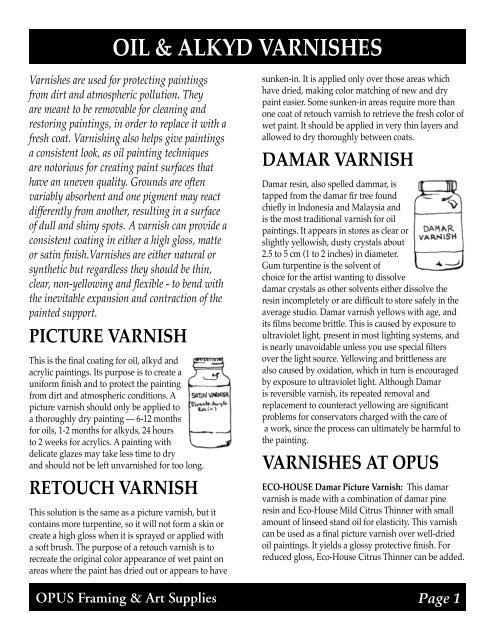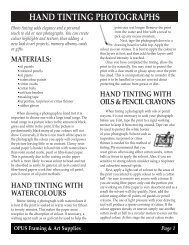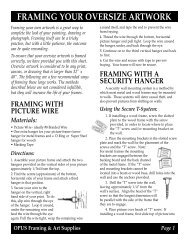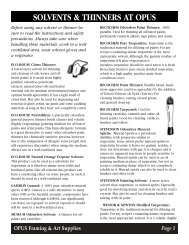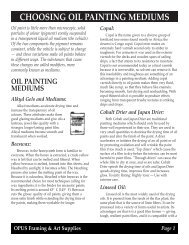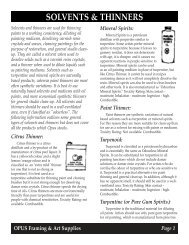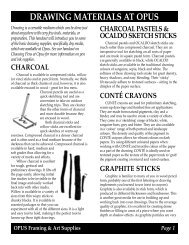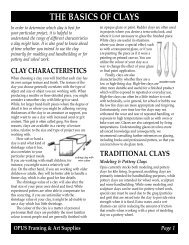OIL & ALKYD VARNISHES - Opus Art Supplies
OIL & ALKYD VARNISHES - Opus Art Supplies
OIL & ALKYD VARNISHES - Opus Art Supplies
You also want an ePaper? Increase the reach of your titles
YUMPU automatically turns print PDFs into web optimized ePapers that Google loves.
<strong>OIL</strong> & <strong>ALKYD</strong> <strong>VARNISHES</strong><br />
Varnishes are used for protecting paintings<br />
from dirt and atmospheric pollution. They<br />
are meant to be removable for cleaning and<br />
restoring paintings, in order to replace it with a<br />
fresh coat. Varnishing also helps give paintings<br />
a consistent look, as oil painting techniques<br />
are notorious for creating paint surfaces that<br />
have an uneven quality. Grounds are often<br />
variably absorbent and one pigment may react<br />
differently from another, resulting in a surface<br />
of dull and shiny spots. A varnish can provide a<br />
consistent coating in either a high gloss, matte<br />
or satin finish.Varnishes are either natural or<br />
synthetic but regardless they should be thin,<br />
clear, non-yellowing and flexible - to bend with<br />
the inevitable expansion and contraction of the<br />
painted support.<br />
PICTURE VARNISH<br />
This is the final coating for oil, alkyd and<br />
acrylic paintings. Its purpose is to create a<br />
uniform finish and to protect the painting<br />
from dirt and atmospheric conditions. A<br />
picture varnish should only be applied to<br />
a thoroughly dry painting — 6-12 months<br />
for oils, 1-2 months for alkyds, 24 hours<br />
to 2 weeks for acrylics. A painting with<br />
delicate glazes may take less time to dry<br />
and should not be left unvarnished for too long.<br />
RETOUCH VARNISH<br />
This solution is the same as a picture varnish, but it<br />
contains more turpentine, so it will not form a skin or<br />
create a high gloss when it is sprayed or applied with<br />
a soft brush. The purpose of a retouch varnish is to<br />
recreate the original color appearance of wet paint on<br />
areas where the paint has dried out or appears to have<br />
sunken-in. It is applied only over those areas which<br />
have dried, making color matching of new and dry<br />
paint easier. Some sunken-in areas require more than<br />
one coat of retouch varnish to retrieve the fresh color of<br />
wet paint. It should be applied in very thin layers and<br />
allowed to dry thoroughly between coats.<br />
DAMAR VARNISH<br />
Damar resin, also spelled dammar, is<br />
tapped from the damar fir tree found<br />
chiefly in Indonesia and Malaysia and<br />
is the most traditional varnish for oil<br />
paintings. It appears in stores as clear or<br />
slightly yellowish, dusty crystals about<br />
2.5 to 5 cm (1 to 2 inches) in diameter.<br />
Gum turpentine is the solvent of<br />
choice for the artist wanting to dissolve<br />
damar crystals as other solvents either dissolve the<br />
resin incompletely or are difficult to store safely in the<br />
average studio. Damar varnish yellows with age, and<br />
its films become brittle. This is caused by exposure to<br />
ultraviolet light, present in most lighting systems, and<br />
is nearly unavoidable unless you use special filters<br />
over the light source. Yellowing and brittleness are<br />
also caused by oxidation, which in turn is encouraged<br />
by exposure to ultraviolet light. Although Damar<br />
is reversible varnish, its repeated removal and<br />
replacement to counteract yellowing are significant<br />
problems for conservators charged with the care of<br />
a work, since the process can ultimately be harmful to<br />
the painting.<br />
<strong>VARNISHES</strong> AT OPUS<br />
ECO-HOUSE Damar Picture Varnish: This damar<br />
varnish is made with a combination of damar pine<br />
resin and Eco-House Mild Citrus Thinner with small<br />
amount of linseed stand oil for elasticity. This varnish<br />
can be used as a final picture varnish over well-dried<br />
oil paintings. It yields a glossy protective finish. For<br />
reduced gloss, Eco-House Citrus Thinner can be added.<br />
OPUS Framing & <strong>Art</strong> <strong>Supplies</strong> Page
<strong>OIL</strong> & <strong>ALKYD</strong> <strong>VARNISHES</strong><br />
GAMBLIN Gamvar: Gamvar is a low molecular<br />
weight, synthetic resin varnish that has a refractive<br />
index similar to damar natural varnish. Applying<br />
it as a top layer will saturate the colors of your<br />
paintings and intensify the transparency of glazes.<br />
While varnishing is an aesthetic decision made by<br />
individuals, historically varnishes protect paintings<br />
from environmental dirt and dust. Gamvar contains<br />
an ultraviolet light stabilizer which protects paintings<br />
from UV radiation.<br />
GOLDEN MSA Varnish with UVLS: A mineral<br />
spirit soluble Acrylic (MSA) varnish that incorporates<br />
a system of UltraViolet Light filters and Stabilizers<br />
(UVLS). Removable for conservation. Physically<br />
tougher than waterborne acrylic varnishes. Protects<br />
from UV damage. Adheres to a wide variety of surfaces<br />
and paint mediums, including acrylics, oils, alkyds,<br />
pastels, watercolours and temperas. Non-yellowing.<br />
KRYLON Kamar: Clear, non-yellowing, restores<br />
brilliance of “sunken-in” colours. It allows for the<br />
temporary protection and retouch workability on<br />
paintings which aren’t dry. Developed as a synthetic<br />
alternative to traditional damar varnish in a convenient<br />
aerosol spray can.<br />
OPUS Vancouver<br />
1360 Johnston St<br />
604-736-7028<br />
OPUS Kelowna<br />
1357 Ellis St<br />
250-763-3616<br />
LIQUITEX Soluvar: Pure acrylic spirit varnish for oil<br />
and acrylic paintings. It is removable with mineral<br />
spirits or turpentine. Paintings must be completely dry.<br />
STEVENSON Damar Crystals: Comes in clear or<br />
slightly yellowish crystals about 2.5 to 5 cm (1 - 2”) in<br />
diameter. Gum turpentine is often used to dissolve the<br />
crystals as many other solvents either dissolve the them<br />
incompletely or are not safe for keeping in the studio.<br />
Damar varnish yellows with age, and its film become<br />
brittle. Damar is reversible, but its repeated removal<br />
and replacement to counteract yellowing are significant<br />
problems for conservators since the process can be<br />
ultimately harmful to the painting.<br />
STEVENSON Satin Varnish & Medium: Gives a satin,<br />
low-gloss clear finish that is weather-resistant, water<br />
and humidity-proof. Removable with turpentine for<br />
cleaning purposes. May be applied with a soft brush or<br />
diluted for a spray. As a re-touch varnish it softens to<br />
permit binding of the under-painting with the overlay,<br />
yet the colours will not mix together. For glazing it may<br />
be mixed with tube colours to give a transparent effect.<br />
It can also be used as a binder to mix with dry pigments<br />
or other materials like sand to create different effects.<br />
OPUS Langley<br />
95 - 5501 204 St<br />
604-533-0601<br />
OPUS North Vancouver<br />
120 Lonsdale Ave<br />
604-904-0447<br />
www.opusframing.com<br />
OPUS Victoria<br />
512 Herald St<br />
250-386-8133<br />
OPUS National<br />
Mail Order Service<br />
1-800-663-6953<br />
OPUS Framing & <strong>Art</strong> <strong>Supplies</strong> Page


